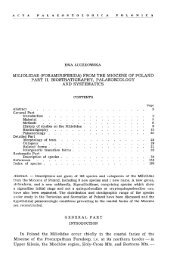Full text - Acta Palaeontologica Polonica
Full text - Acta Palaeontologica Polonica
Full text - Acta Palaeontologica Polonica
Create successful ePaper yourself
Turn your PDF publications into a flip-book with our unique Google optimized e-Paper software.
332 ACTA PALAEONTOLOGICA POLONICA 56 (2), 2011<br />
Colour pattern description.—The pattern consists of three<br />
levels of residual colouration. The background is heteroge−<br />
neous with a fluorescent spiral stripe located just below the<br />
subsutural step (Fig. 2A1). The apex is paler. The diffuse<br />
stripe varies in breadth and the whorl is sometimes almost<br />
entirely fluorescent (excepting the subsutural step and the<br />
base). In the latter case, the stripe may have a different colour<br />
(more orange) and is still distinguishable. An additional thin<br />
median stripe is seen (Fig. 2A2) in several specimens.<br />
Ampullina parisiensis (d’Orbigny, 1850)<br />
Fig. 2B, C.<br />
Stratigraphic and geographic range.—Early Eocene, Ypre−<br />
sian (Cuisian)–Middle Eocene, Bartonian and Priabonian<br />
(PB, Cotentin, HB).<br />
Colour pattern description.—The residual pattern is variable<br />
and consists of three levels of residual colouration. The back−<br />
ground is heterogeneous with one (Fig. 2B, C1) or two fluo−<br />
rescent spiral stripes and the apex is pale (Fig. 2C1). The tran−<br />
sition between the two levels of residual colouration of the<br />
background is diffuse. There are usually two fluorescent<br />
stripes: a broad one on the adapical part and a thinner one on<br />
the adbasal part (Fig. 2C2). The width of the adapical stripe<br />
varies among specimens. Sometimes there are two thin ad−<br />
basal stripes very close to each other instead of one. The<br />
adbasal stripe is sometimes absent and several specimens<br />
have an additional thin subsutural fluorescent stripe. Some<br />
specimens display a single broad stripe spreading on the ma−<br />
jor part of the whorl. Although the whorl could be almost en−<br />
tirely fluorescent (excepting the subsutural step and the<br />
base), the adapical stripe is sometimes in a different colour<br />
(more orange) and remains distinguishable.<br />
Comments on the residual colour pattern of A. depressa<br />
depressa and A. parisiensis.—Several hypotheses can be ad−<br />
vanced to explain the occurrence of two different colours in<br />
the background fluorescence: (i) the chemical nature of the<br />
incorporated pigments; (ii) the concentration of the incorpo−<br />
rated pigments; (iii) the modalities of incorporation. The first<br />
two hypotheses appear plausible. Previous studies, chro−<br />
matographic (Comfort 1949a–c, 1950, 1951; Nicholas and<br />
Comfort 1949) and spectrometric (Hedegaard et al. 2006)<br />
analyses, have indeed revealed differences in the nature of<br />
the substances involved in the pigmentation of gastropod<br />
shells. Moreover Hedegaard et al. (2006) also indicated that<br />
there is no simple relationship between pigment, colour and<br />
taxa: different colours within a single taxon may be due to<br />
different pigments or different saturations of colour can be<br />
generated by different concentrations of the same pigment.<br />
Ampullina rustica (Deshayes, 1864)<br />
Fig. 2D.<br />
Stratigraphic and geographic range.—Middle Eocene, Lute−<br />
tian (PB, Cotentin).<br />
Colour pattern description.—The shells show three levels of<br />
residual colouration. The background is heterogeneous with a<br />
dark subsutural step and a wide fluorescent area covering the<br />
major part of the whorl (Fig. 2D2). The apex is pale. The tran−<br />
sition between the fluorescent area and the darker area of the<br />
background is mostly diffuse. The absence of fluorescence on<br />
the subsutural step induces a dark straight spiral “stripe” (Fig.<br />
2D1). The base of the whorl may be dark too. Sometimes, there<br />
are also slightly darker thin and diffuse spiral “stripes” on the<br />
last whorl due to a localized lack of fluorescence. These<br />
“stripes” are related to obsolete spiral “microlines” and their<br />
number and distribution are variable. The residual colour pat−<br />
tern is very similar to that of A. grossa (Deshayes, 1864) from<br />
the Lutetian–Bartonian of the Paris Basin (Fig. 2E).<br />
Ampullina chenayensis Cossmann, 1892<br />
Fig. 2F.<br />
Stratigraphic and geographic range.—Late Palaeocene, Tha−<br />
netian (PB).<br />
Colour pattern description.—The pattern consists of three<br />
levels of residual colouration: a heterogeneous background<br />
with three spiral fluorescent stripes (Fig. 2F) and a pale apex.<br />
The transition between the two levels of colouration is dif−<br />
fuse. The median stripe is slightly broader than the two others<br />
(Fig. 2F1). Ampullina aizyensis (Bayan, 1870)<br />
Fig. 2G, H.<br />
Stratigraphic and geographic range.—Late Palaeocene, Tha−<br />
netian–Early Eocene, Ypresian (Cuisian) (PB).<br />
Colour pattern description.—The pattern consists of three<br />
levels of residual colouration. The background is heteroge−<br />
neous with three fluorescent spiral stripes (Fig. 2G, H) and<br />
the apex is pale. The transition between the two levels of re−<br />
sidual colouration of the background is diffuse. These stripes<br />
are located on the shoulder and on the median and adbasal<br />
parts of the whorl. Their thickness is not homogeneous on the<br />
shell and varies among specimens (Fig. 2G, H1). Comments.—The figured shells (Fig. 2G, H) are from the<br />
Thanetian of Bachivillers (France, PB) from where this spe−<br />
cies’ occurrence has never been listed. However their shell<br />
shape, oblong with slightly elevated and turreted spire and<br />
tabulate whorls, differs obviously from the sole previously<br />
known Thanetian species A. chenayensis (Fig. 2F) which is<br />
globose with a low spire and lacks tabulate whorls. We con−<br />
sider that our specimens display the characteristic morphol−<br />
ogy of the Cuisian species A. aizyensis and that they repre−<br />
sent the oldest known occurrence of this species.<br />
Ampullina stampinensis (Cossmann and Lambert,<br />
1884)<br />
Fig. 2I.<br />
Stratigraphic and geographic range.—Early Oligocene,<br />
Rupelian (Stampian) (PB).<br />
Colour pattern description.—The shells show two levels of<br />
residual colouration under UV light (apex absent). The back−<br />
ground is dark and heterogeneous with three spiral fluores−
















